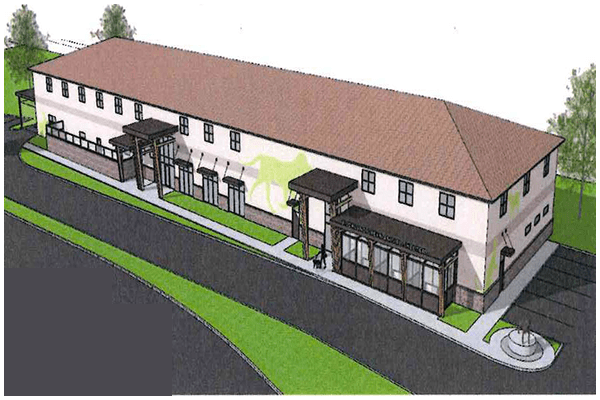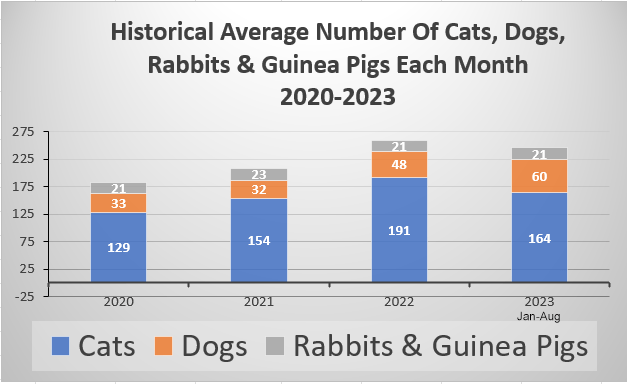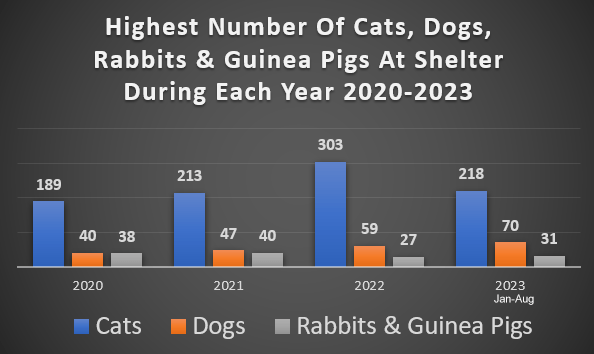|
RCBJ-Audible (Listen For Free)
|
Feasibility Report Commissioned By Rockland Green Reveals Plans For An Animal Shelter Many Say Will Not Adequately Accommodate County’s Historical Shelter Needs
By Tina Traster
Rockland Green is gearing up to convert a warehouse on Ecology Road in the Village of West Haverstraw to a countywide municipal animal shelter and estimates it will cost $18 million. But based on its history of change orders and cost overruns at its Material Recovery Facility in Hillburn, just how accurate its estimates and forecasts are remain to be seen.
From the start, Rockland Green’s Chairman Howard Phillips told the Rockland County Legislature and the public it would cost about $4 million to buy the 15,000 square-foot warehouse and a “few million more to turn it into an animal shelter.” To date, the shelter’s projected estimates have risen above $18 million. Similarly, in 2021, Rockland Green undertook an effort to build a Materials Recovery Facility (MRF) in Hillburn, and bonded $35 million to pay for it, but an examination of the public authority’s resolutions over the past two years shows the project has required over 175 “change orders” or increases to the bottom line. Change orders increased some contracts by 15 percent or more, and in one case by over $1 million.
Rockland Green, which commandeered Hi Tor Animal Shelter last year, and has hired architects and consultants to design the proposed animal shelter, is planning shelter space for 116 cats and 53 dogs a report shows – a woefully inadequate number, according to several former Hi Tor employees and volunteers. In the Project Labor Agreement Feasibility Study, dated December 3, 2023 and prepared by Arace & Company Consulting LLC of Warwick, NY, there is also no mention or accommodation of planning for small animals such as rabbits or guinea pigs.
Based on reports Rockland Green was given in early 2023 by Hi Tor, and information Hi Tor provided to Rockland Green’s architects and consultants that outlined animal populations at the shelter over time, as well as monthly reports on populations and adoption rates, there were between 125 and 200 felines on average per month needing space. This doesn’t include the scores of cats in the outdoor feral colony, nor does it account for the numbers of kittens that swell the population during the spring breeding season.
But the average number of animals doesn’t tell the full story, particularly when two recent years of data were during the pandemic. A closer look at the highest number of animals during each year, reveals the shelter’s total space needs during “kitten season” — that time of the year when kittens (with and without mothers) arrive daily at the shelter. In 2022, at its peak, the shelter needed space for 303 felines. In 2023, canine population peaked at 70 dogs.
Rockland Green is planning a shelter that does not have the capacity to handle the volume of animals historically cared for in Rockland County. Accommodations for 116 cats and 53 dogs is well below the documented needs of the county. Based on the underestimated numbers, it is unclear whether Rockland Green’s RG Cares animal shelter is planning to turn away stray and unwanted animals, manage population control through euthanasia, or will ultimately change its plans to match more realistic needs.
What also remains uncertain is whether the municipal county-wide shelter will be able to build or maintain the kind of foster network Hi Tor once had. The long struggling largely defunct nonprofit relied on armies of humanitarians to foster dogs, cats and small animals because the shelter was overcrowded, or an animal could not function in the shelter environment, or was otherwise not safe. RG Cares, however, is a government agency that plans to tax Rockland County residents $1.7 million in 2024 — an 18 percent increase over last year — with taxes continuing to rise as the public authority bonds for the project and potentially needs to raise even more funds than it has accounted for because of poor planning. Numbers may increase because a publicly-run shelter is less likely to enjoy open arms from a foster care community.
It is important to remember that Rockland Green is a public authority that has broad powers to levy taxes. While every town supervisor, two mayors, nine legislators, and Steve Powers from the County Executive office sits on Rockland Green’s board and votes for spending on projects, residents often say they feel powerless when it comes to the authority’s taxing and planning decisions. Largely they’re right because Rockland Green’s projects are not put to public referenda and dissatisfaction about the authority’s decisions rarely punish individual members (public officials) who sit on the board.
For the most part, Rockland Green is viewed as a monolith with outsized power. Typically, the public does not attend the authority’s monthly meetings in Clarkstown town hall either because they are held at 5 pm or because the public is unaware of Rockland Green in the first place. But if they had attended, they would know the Materials Recovery Facility, or MRF, has been a project with more than 175 spending additions.
The MRF was built with a Project Labor Agreement, which are pre-hire collective bargaining agreements used on public and private construction projects. PLAs set standardized terms and conditions of employment for construction workers on the job site.
In 2021, Rockland Green bonded $35 million to build the MRF and issued contracts in accordance with competitive bids based on drawings and plans that were repeatedly revised for accuracy, according to its records. Contracts were awarded to contractors, electricians, plumbers, and others. But each of these contracts were altered through “change orders” that the board of Rockland Green approved, adding millions to the project. For example, there were 111 change orders for the Butler Construction contract, 28 change orders for Rockland Electric, and more than 20 change orders for Fire Protection.
Rockland Green, according to its latest published financial statement carries about $50 million in bond debt, and has allocated about $8 million dollars in its fiscal year 2024 budget for payment of interest and principal on its debt.
It may not be unusual for a project to morph and evolve with extra expenses, but the MRF may cause those watching the shelter project to worry.
One former public official who spoke anonymously said “Rockland Green rubber stamps everything, and they have an open checkbook to do it with.”
In January, Rockland Green completed the purchase of the 15,000 square-foot warehouse building on Ecology Road for $3.8 million. Taxpayers also paid for renting the facility in 2023 for $225,000 before any construction began. That rental was not applied to the purchase price.
It has been estimated the shelter will cost upwards of $18 million; Rockland Green recently authorized Bond Anticipation Notes in the amount of $10 million, much of which will be spent on reimbursing Rockland Green for the purchase and closing costs on the warehouse, architectural plans, consulting fees, the feasibility studies and legal fees. Additional bonding will be more than necessary for Rockland Green’s vision for the shelter, which includes many functions, as well as six workstations with separate offices for “upper management.”
The feasibility study commissioned by Rockland Green, which includes building a second floor into the warehouse, recommends the authority use a Project Labor Agreement (PLA) for the project. PLAs traditionally engage apprentice labor and seek concessions on overtime.
The Arace report estimates the total “hard” cost (which excludes escalations, phasing, overhead, insurance, bonds, design, and contingencies) to be $10 million, and for construction to begin on May 1, 2024. The project is expected to take a year to build. Irregular shift work and overtime is not expected to exceed 5 percent. Assuming a single eight-hour shift, five days a week, and excluding weekends and holidays, the total time to complete the project is estimated to be 251 workdays with a labor budget of about 37,914 work hours, an average cost of $15,931 per day and 151 average work hours per day.
The 13 prime building trades for this project are carpenter, electrician, glazier, iron worker, laborer, mason, operating engineer, painter, plumber, roofer, sheet metal, sprinkler fitter, teamster. The average hourly wage is estimated at $105.50.
The Arace study calls for five dog adoption wards, meet-and-greet rooms, laundry and bathing room, hold rooms, an adoption lobby, a surrender lobby. The projected plan also calls for a large conference room, a locker room for staff, a second-floor indoor training and exercise room, a large second-floor community room, and a second-floor mezzanine with lounge areas.
Estimates include air handling systems to mitigate the spread of zoonotic or communicable disease commonly found in a shelter environment but there is no allocation for noise proofing the shelter, even though a large truck depot is proposed across the street from the shelter. Also planned are five canine yards, though it is unclear how the project will create outdoor facilities, including walking trails, for the dogs. For the cats, features include five congregation rooms, five “catios”, meet-and-greet rooms and two cat condo rooms.
Rockland Green’s vision for the shelter also includes intake, exam, treatment/recovery and surgery rooms – meaning the county’s shelter animals will be treated onsite, rather than at area veterinarians. This too presumes the hiring of on-site veterinarians and technicians. There is no budget allocation for a crematorium, but the plan does call for a large walk-in freezer, the purpose of which is to store deceased and/or euthanized animals.













